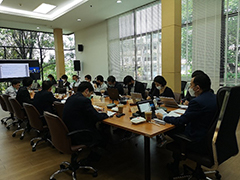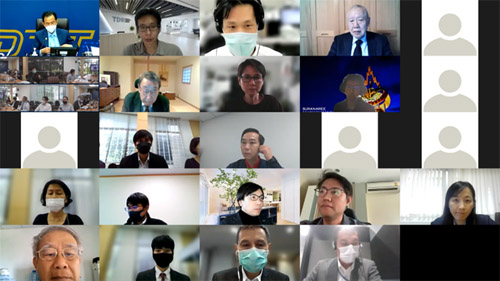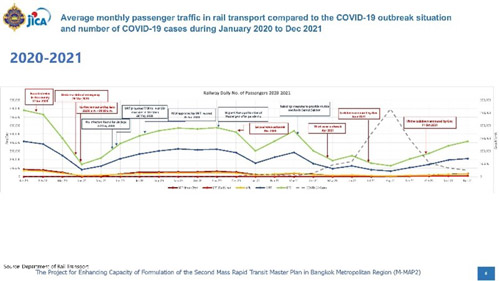- Home
- Technical Cooperation Projects
- Index of Countries
- Asia
- Thailand
- Project for enhancing capacity of formulation of the Second Mass Rapid Transit Master Plan in Bangkok Metropolitan Region (M-MAP2)
- Project News
- The Second Railway Demand Forecast Working Group was held.
Project News
The Second Railway Demand Forecast Working Group was held.
On March 4, 2022, the Department Rail Transport (DRT) held the second meeting of the Demand Forecast Working Group.
Following the first WG, the progress of the DRT consultant's work to formulate M-MAP2 was presented. Academia experts both from Thailand and Japan provided useful comments on it. The meeting was held in a hybrid manner, at DRT's meeting room and through online participation.
Following opening remarks by Dr. Pichet KUNADHAMRAKS, Deputy Director General of DRT. DRT consultants presented the current population estimation and future projection methodology (see Project News No. 2), and on the progress of the traffic survey and demand forecasting model for the M-MAP2. The academic experts gave the following advice on how to set up a railway demand forecasting model.
- The demand forecast model should be able to capture the characteristics of Bangkok's transportation behavior. For example, how to reflect the trip of the parents who drop their children at the school before going to work, in the model.
- It is necessary to establish a demand forecasting model that takes into account not only vehicle ownership but also income level. For example, higher income groups have tendency not to use railway. On the other hand, high-income households without private cars are more likely to use the railway, while low-income household are more likely to use buses.
- In order to promote the use of railway, measures that limit the use of private cars, for example, parking policies, need to be evaluated.
The JICA expert team also made a presentation on the changes of urban railway passenger after the COVID-19 infection spread: immediately after the COVID-19 infection spread, the number of railway users declined sharply due to measures taken to curb the spread of the infection, such as curfew, encouraging people to work at home, and closing schools. The number of passengers recovered when the COVID-19 outbreak in Thailand calmed down, but along with the second or third wave of COVID-19, the number of railway passengers declined, and the degree of recovery thereafter has been gradually weakening. It was noted that before the COVID-19 expansion, more than 1 million people used urban railway, but now, despite the absence of any restrictions, the number of daily passenger is only about 700,000.
Based on the results of discussion at this meeting, DRT Consultant together with JICA Expert Team continues to prepare for traffic survey and to set up demand forecasting model to evaluate railway policy
 Opening remark by Dr. Pichet KUNADHAMRAKS, Deputy Director General of DRT
Opening remark by Dr. Pichet KUNADHAMRAKS, Deputy Director General of DRT
 Online participants.
Online participants.
 Change of railway users during COVID-19
Change of railway users during COVID-19
- About JICA
- News & Features
- Countries & Regions
- Our Work
- Thematic Issues
- Types of Assistance
- Partnerships with Other Development Partners
- Climate Change / Environmental and Social Considerations
- Evaluations
- Compliance and Anti-corruption
- Science and Technology Cooperation on Global Issues
- Research
- JICA Development Studies Program / JICA Chair
- Support for the Acceptance of Foreign HRs / Multicultural and Inclusive Community
- Publications
- Investor Relations
